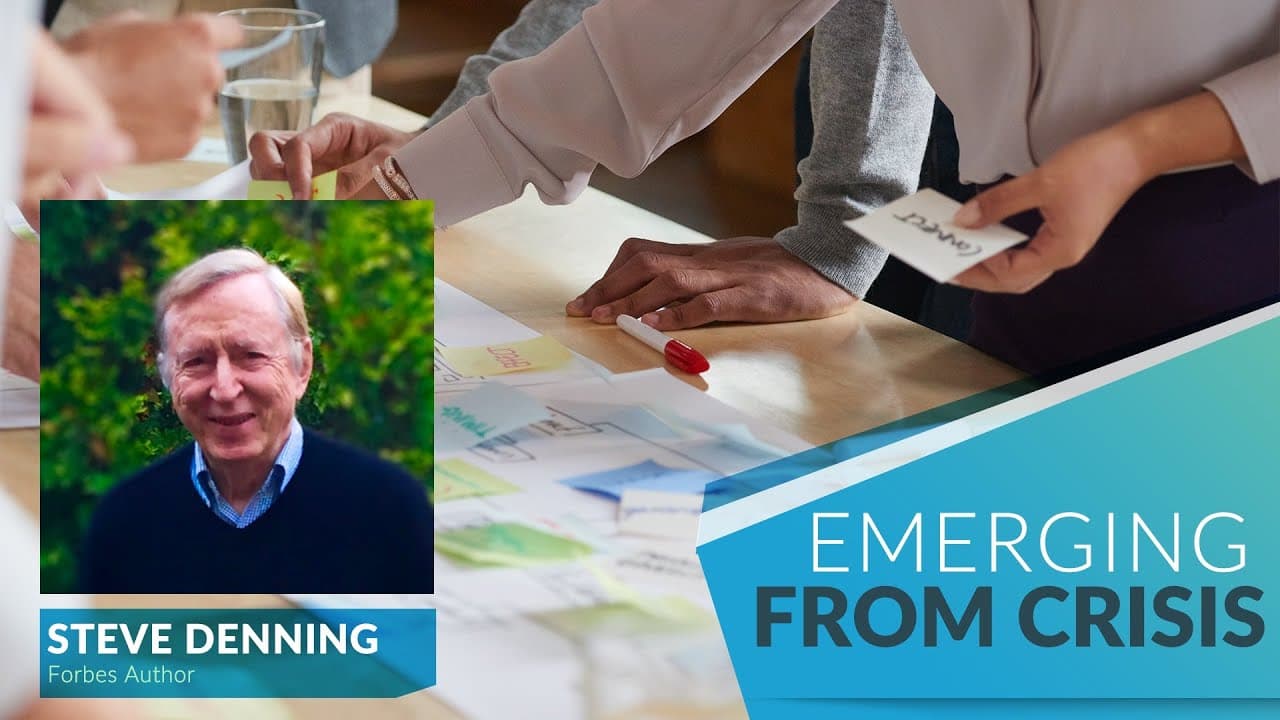Good morning or good afternoon, wherever you happen to be. My name is Steve Denning, and I’m coming to you today from Washington, D.C. I’m happy to be with you at this important conference about emerging from the crisis.
However, I must admit that I have a problem with the topic of “emerging from the crisis.” Here in the United States, we are not anywhere near emerging from the crisis. At best, we are in the middle of it—perhaps even still at the beginning. Moreover, we are not dealing with a single crisis but multiple interlocking crises: a health crisis, an economic crisis, and a crisis of racial inequality.
The Reality of the Health Crisis
It’s hard to be optimistic about the health crisis in the U.S. ending anytime soon. The virus shows no signs of going away. Already, more than 100,000 people have died, and the disease continues to spread as businesses reopen and control measures relax. With no vaccine or treatment in sight, the crisis is far from over. In a global ranking of country performance in handling the pandemic, the U.S. ranks 58th—just after Romania and before the Slovak Republic. It is a humbling result for the world’s most advanced economy. The need for greater agility in handling health crises is staring us in the face.
The Economic Crisis
On the economic front, more than 30 million people have lost their jobs, and the U.S. economy is in deep recession, or even a depression. Despite massive government assistance and remarkably agile actions by the Federal Reserve, millions of small businesses remain at risk. Frustration is running high.
The Stock Market’s Alternate Reality
Yet, amid these three ongoing interlocking crises, there is one bright spot: the stock market. It seems to be living in an alternate universe, brimming with optimism. After a brief decline, indices have jumped back and even reached new highs. This growth has been driven by the big five tech firms, now the most valuable companies on the planet. Together, they are worth more than $5 trillion—equivalent to a quarter of the United States economy. Just two of them are worth more than the entire stock market of the United Kingdom.
What sets these firms apart? They embody recognizably agile principles, even if expressed in different language. They obsess over customer value, work primarily in small, self-organizing teams, and operate as networks of competence rather than top-down hierarchies. These companies have become the most valuable in history—not despite the crisis, but during it. Agility is a key enabler of their success.
Agile’s Takeover of Management
Agile is no longer just a set of ideas from a group of unhappy software developers in 2001. By 2020, something remarkable had happened: Agile thinking had taken over the management world. What began as a rebellion against traditional management has now been embraced by the very people it sought to circumvent.
Today, Agile is not just about scaling within organizations—it has transformed management itself. In Wall Street terminology, Agile has carried out a successful takeover bid of traditional management. In short, Agile is eating the world.
However, this is not a time for complacency. It is a time to rethink Agile’s basic assumptions, take stock of what has happened, and prepare for future crises and challenges.
Rethinking Agile: Ten Hypotheses
There are at least ten important areas where Agile needs to be rethought, falling into three categories:
- Rethinking the very concept of business agility
- Rethinking the processes of business agility
- Addressing the diseases of business agility
Rethinking the Concept of Agile
1. Agile Mindset vs. Agile Principles
For years, the Agile community has emphasized the importance of an Agile mindset. But what if this was a linguistic mistake? The term “mindset” is vague, nebulous, and often misinterpreted as cult-like. Instead, what if we focused on Agile principles?
Principles, like the Ten Commandments in religion, serve as guiding rules of conduct. They provide direction without being dogmatic. My hypothesis is that it would be easier to communicate Agile with a small set of specific principles rather than an abstract mindset.
2. Strategic Agility Over Operational Agility
Agile has mainly focused on operational agility—making existing products better for existing customers. However, as the coronavirus crisis has demonstrated, a truly Agile firm must also create new businesses and attract new customers. Strategic agility will become more critical than operational agility in the coming years.
3. Agile in Hardware
Most Agile principles evolved in software development. But Agile in hardware remains largely unexplored. Bytes and atoms behave differently, requiring different approaches. We need more analysis of how Agile applies to hardware development.
4. Agile in the Public Sector
Most Agile literature focuses on the private sector. Yet, some of the most pressing challenges—such as handling the coronavirus crisis—lie in the public sector. We need to study how Agile principles apply when there is no traditional “customer” and multiple political stakeholders.
Rethinking Agile Processes
5. The Role of the C-Suite
Agile originated at the base of organizations and gradually spread upward. But we still have little insight into how an Agile C-suite operates. More examples and case studies are needed.
6. Working Face-to-Face vs. Virtual Work
One of Agile’s core tenets has been face-to-face collaboration. The pandemic forced organizations to embrace remote work, and many found it surprisingly effective. Perhaps Agile needs to adapt to reflect this shift.
7. Reinventing HR
Traditional HR is a relic of bureaucracy, treating people as resources rather than individuals. We need to transform HR into a function that enables employees to maximize customer value.
8. Budgeting
Annual budgets are cumbersome, slow, and out of date by the time they are approved. However, the problem isn’t with the budget itself—it’s with the underlying structures of organizations. To fix budgeting, we must address broader organizational dysfunctions.
Addressing the Diseases of Agile
9. Fake Agile
Many firms claim to be Agile but are merely Agile in name. Fake Agile risks discrediting real Agile. We need clearer definitions and a focus on principles rather than labels.
10. The Dark Side of Agile
As Agile firms become dominant, some have also become monopolies, engaging in anti-competitive behavior and misusing customer data. The Agile community must document and address these ethical concerns.
Conclusion
We need to rethink the concept of Agile, refine Agile processes, and confront the challenges that threaten Agile’s integrity. I have offered ten hypotheses for discussion. If you would like to participate in reviewing drafts of my upcoming book on this subject, send me an email at [email protected]. Let’s get to work.



